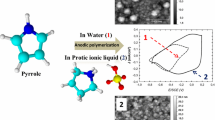Abstract
The influence of different divalent cations (M2+) on the electrochemical charging/discharging process of polypyrrole/sulfate (PPy/SO4) films has been investigated. In principle, two different types of M2+ were found: (a) cations that cause the break-in phenomenon in the PPy film during electrochemical cycling with a gradual increase of film electroactivity and (b) cations in whose solutions the PPy film remains mainly electroinactive. Certain correlations have been drawn between several physico-chemical properties of the investigated cations and the break-in and passivation phenomena. The break-in and passivation phenomena were found to be influenced by the size and deformability of the cation hydration shell, ion covalent index and softness, as well as by the pH value of the test solution.



Similar content being viewed by others
References
Inzelt G (1989) Electrochim Acta 34:83
Pei Q, Inganäs O (1993) J Phys Chem 97:6034
Gandhi MR, Murray P, Spinks GM, Wallace GG (1995) Synth Met 73:247
Tamm J, Hallik A, Alumaa A, Sammelselg V (1997) Electrochim Acta 42:2929
Lee H, Yang H, Kwak J (1999) J Electroanal Chem 468:104
Hallik A, Alumaa A, Sammelselg V, Tamm J (2001) J Solid State Electrochem 5:265
Fernández Romero AJ, López Cascales JJ, Otero TF (2005) J Phys Chem B 109:21078
Tamm J, Alumaa A, Hallik A, Johanson U, Tamm L, Tamm T (2002) Russ J Electrochem 38:182
Iseki M, Saito K, Ikematsu M, Sugiyama Y, Kuhara K, Mizukami A (1993) J Electroanal Chem 358:221
Inzelt G, Kertész V, Nybäck AS (1999) J Solid State Electrochem 3:251
Li Y, Qian R (1993) J Electroanal Chem 362:267
Alumaa A, Hallik A, Mäeorg U, Sammelselg V, Tamm J (2004) Electrochim Acta 49:1767
Weidlich C, Mangold K-M, Jüttner K (2005) Electrochim Acta 50:1547
Hallik A, Alumaa A, Tamm J, Sammelselg V, Väärtnõu M, Jänes A, Lust E (2006) Synth Met 156:488
Gohil GS, Binsu VV, Shahi VK (2006) J Membr Sci 280:210
Misoska V, Ding J, Davey JM, Price WE, Ralph SF, Wallace GG (2001) Polymer 42:8571
Reece DA (2003) Development of conducting polymers for separations. PhD Thesis, University of Wollongong
Iseki M, Saito K, Kuhara K, Mizukami A (1991) Synth Met 40:117
Yakovleva AA (2000) Russ J Electrochem 36:1275
Partridge AC, Milestone C, Too CO, Wallace GG (1997) J Membr Sci 132:245
Davey JM, Ralph SF, Too CO, Wallace GG (1999) Synth Met 99:191
Marcus Y (1997) Ion properties. Marcel Dekker, New York
McCloskey J, Newman MC, Clark SB (1996) Environ Toxicol Chem 15:1730
Krestov GA (ed) (1987) Ionnaya Solvatatzya. Nauka, Moskva
Hallik A, Alumaa A, Kurig H, Jänes A, Lust E, Tamm J (2007) Synth Met 157:1085
Available at http://andrew.ucsd.edu/courses/sio263/ClassNotes/3.pdf
Fraústo da Silva JJR, Williams RJP (2004) The biological chemistry of the elements—the inorganic chemistry of life (part 1). Oxford University Press, Oxford
Zhang X, Bai R (2003) Langmuir 19:10703
Deslouis C, El Moustafid T, Musiani MM, Tribollet B (1996) Electrochim Acta 41:1343
Leaist DG, Goldik JS (2001) J Solution Chem 30:103
Zhang Y-H, Chan CK (2002) J Phys Chem A 106:285
Vermaas FHC, Schmidt ER (1959) Beitr Mineral Petrogr 6:219, http://www.springerlink.com/content/r67312rpv4020171/fulltext.pdf
Janoš P (1993) J Chromatogr A 657:435
Daniele PG, Rigano C, Sammartano S (1982) Inorg Chim Acta 63:267
Glusker JP, Katz AK, Bock CW (1999) Rigaku J 16:8
Elinder F, Århem P (2004) Q Rev Biophys 36:373
Author information
Authors and Affiliations
Corresponding author
Rights and permissions
About this article
Cite this article
Hallik, A., Alumaa, A. & Tamm, J. On the break-in and passivation phenomena in polypyrrole/sulfate films. J Solid State Electrochem 14, 909–916 (2010). https://doi.org/10.1007/s10008-009-0995-y
Received:
Revised:
Accepted:
Published:
Issue Date:
DOI: https://doi.org/10.1007/s10008-009-0995-y




